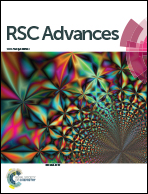“Quick and click” assembly of functionalised indole rings via metal-promoted cyclative tandem reactions†
Abstract
An efficient and convenient synthesis of a variety of decorated indoles using a three-component tandem metal-catalysed process is described. We propose here a new “synthetic kit” that allows for the “quick and click” assembly of indole rings using readily available, and inexpensive starting materials under environmentally friendly reaction conditions.


 Please wait while we load your content...
Please wait while we load your content...